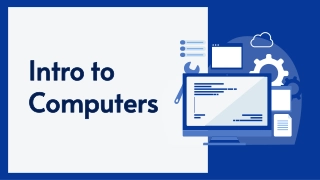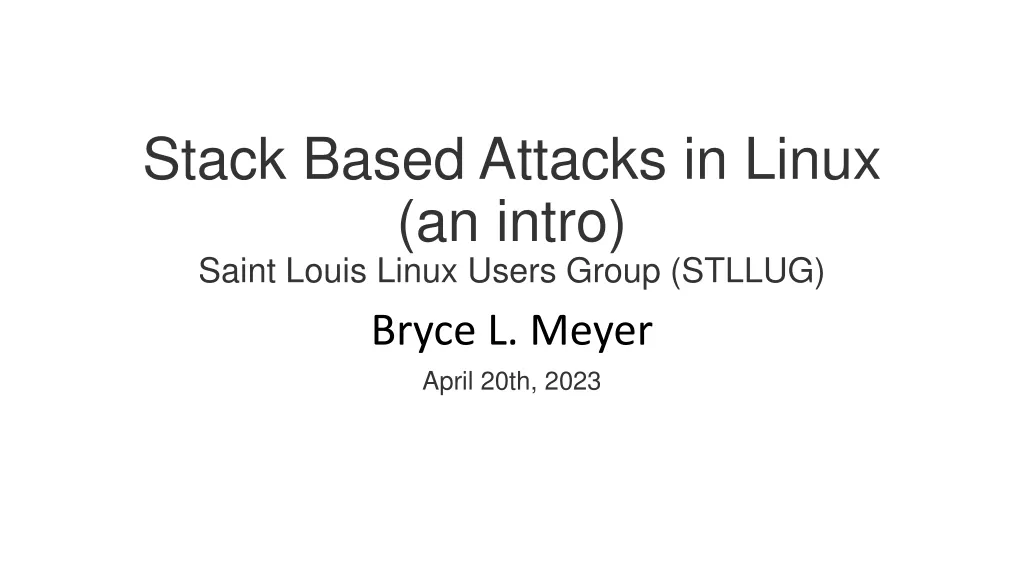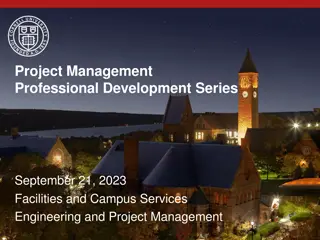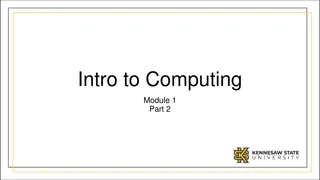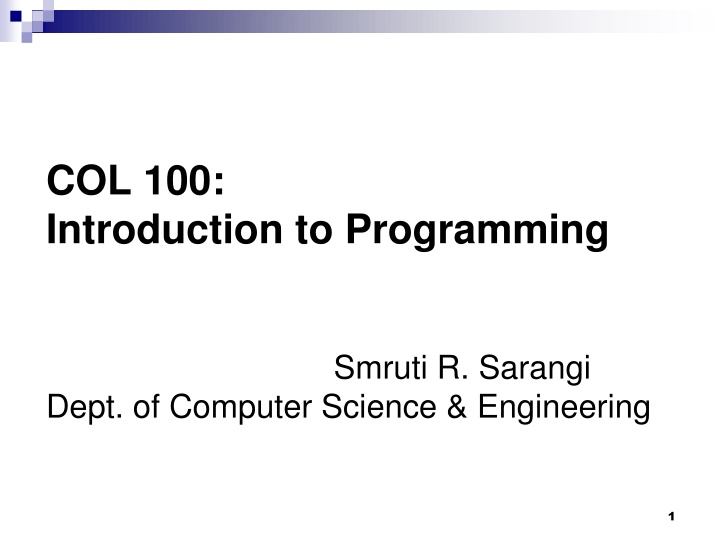
Unveiling the Basics of Computer Programming
Delve into the fundamentals of computer programming with COL.100: Introduction to Programming. Explore the essence of a computer, its functionalities, and the significance of attendance in understanding the course. Discover the inner workings of a computer system and ponder the intelligence behind the most advanced 'computer' – our brains.
Download Presentation

Please find below an Image/Link to download the presentation.
The content on the website is provided AS IS for your information and personal use only. It may not be sold, licensed, or shared on other websites without obtaining consent from the author. If you encounter any issues during the download, it is possible that the publisher has removed the file from their server.
You are allowed to download the files provided on this website for personal or commercial use, subject to the condition that they are used lawfully. All files are the property of their respective owners.
The content on the website is provided AS IS for your information and personal use only. It may not be sold, licensed, or shared on other websites without obtaining consent from the author.
E N D
Presentation Transcript
COL 100: Introduction to Programming Smruti R. Sarangi Dept. of Computer Science & Engineering 1
Course Materials Books: 1. Byron Gottfried, Third Edition, Schaum s Outlines Series, 2. The C Programming Language Brian W Kernighan, Dennis M Ritchie Programming with C (Second Edition) 2
Attendance REALLY matters Important for understanding the course Any student with low attendance may be deregistered from the course Leave due to medical reasons must be certified by the IIT Hospital 3
What is a Computer ? A computer is a general purpose device that can be programmed to process information, and yield meaningful results. 5
Predicted in 1954 Reality 6
How does it work ? Information store Program Computer results Program List of instructions given to the computer Information store data, images, files, videos Computer Process the information store according to the instructions in the program 7
What does a computer look like ? Let us take the lid off a desktop computer CPU Hard disk Memory 8
Hard disk Memory Computer Memory Stores programs and data. Gets destroyed when the computer is powered off Hard disk stores programs/data permanently 9
Let us make it a full system ... Hard disk Memory Computer Keyboard Monitor Mouse Printer 10
Food for Thought... What is the most intelligent computer ? 11
Answer ... Our brilliant brains 12
How does an Electronic Computer Differ from our Brain ? Feature Intelligence Speed of basic calculations Can get tired Can get bored Computer Dumb Ultra-fast Never Never Our Brilliant Brain Intelligent Slow After sometime Almost always Computers are ultra-fast and ultra-dumb 13
How to Instruct a Computer ? execute compile Executable Program Output Write a program in a high level language C, C++, Java Compile it into a format that the computer understands Execute the program 14
What Can a Computer Understand ? Computer can clearly NOT understand instructions of the form Multiply two matrices Compute the determinant of a matrix Find the shortest path between Mumbai and Delhi They understand : Add a + b to get c Multiply a + b to get c 15
The Language of Instructions Humans can understand Complicated sentences English, French, Spanish Computers can understand Very simple instructions The semantics of all the instructions supported by a processor is known as its instruction set architecture (ISA). This includes the semantics of the instructions themselves, along with their operands, and interfaces with peripheral devices. 16
Features of an ISA Example of instructions in an ISA Arithmetic instructions : add, sub, mul, div Logical instructions : and, or, not Data transfer/movement instructions Also called low level instructions Most programmers avoid writing programs in low level instructions. Very complicated, and difficult. 17
Problems with programming using instruction sets directly Instruction sets of different types of CPUs are different Need to write different programs for computers with different types of CPUs even to do the same thing Solution: High level languages (C, C++, Java, ) CPU neutral, one program for many Compiler to convert from high-level program to low level program that CPU understands Easy to write programs 18
Fundamentals: Binary Numbers 20
Representing Positive Integers Ancient Roman System Symbol I V X L C D M Value 1 5 10 50 100 500 1000 Issues : There was no notion of 0 Very difficult to represent large numbers Addition, and subtraction (very difficult) 21
Indian System Bakshali numerals, 7th century AD Uses the place value system 5301 = 5 * 103 + 3 * 102 + 0 * 101 + 1*100 Example in base 10 22
Number Systems in Other Bases Why do we use base 10 ? because ... 23
What if we had a world in which ... People had only two fingers. 24
Representing Numbers 102310 = 1 * 103 + 0 * 102 + 2 * 101 + 3 * 100 Decimal base Binary 1710 = 1 * 24 + 0 * 23 + 0 * 22 + 0 * 21 + 1 * 20 = 100012 Base = 2 25
Binary Number System They would use a number system with base 2. Number in decimal Number in binary 101 1100100 111110100 10000000000 5 100 500 1024 26
MSB and LSB MSB (Most Significant Bit) The leftmost bit of a binary number. E.g., MSB of 1110 is 1 LSB (Least Significant Bit) The rightmost bit of a binary number. E.g., LSB of 1110 is 0 27
Hexadecimal and Octal Numbers Hexadecimal numbers Base 16 numbers 0,1,2,3,4,5,6,7,8,9,A,B,C,D,E,F Start with 0x Octal Numbers Base 8 numbers 0,1,2,3,4,5,6,7 Start with 0 28
Examples Decimal 9 12 17 28 Binary 1001 1100 10001 11100 Octal 0 11 0 14 0 21 0 34 Hexadecimal 0x 9 0x C 0x 11 0x 1C Convert 110010111 to the octal format : 111 = 0612 110 010 Convert 111000101111 to the hex format : 111000101111 = 0xC2F
Bits and Bytes Computers do not understand natural human languages, nor programming languages They only understand the language of bits 0 or 1 0 or 1 0 or 1 0 or 1 Bit Bit 0 or 1 0 or 1 0 or 1 8 bits Byte 0 or 1 0 or 1 0 or 1 4 bytes Word 0 or 1 0 or 1 0 or 1 1024 bytes kiloByte 0 or 1 0 or 1 106 bytes megaByte 30 30
First C program print on screen #include <stdio.h> void main() { printf ("Hello, World! \n") ; } 32
More printing (code and see) #include <stdio.h> void main() { printf ("Hello, World! ") ; printf ("Hello \n World! \n") ; } 33
Some more printing #include <stdio.h> void main() { printf ("Hello, World! \n") ; printf ("Hello \n World! \n") ; printf ("Hell\no \t World! \n") ; } 34
Reading values from keyboard #include <stdio.h> void main() { int num ; scanf ("%d", &num) ; printf ( No. of students is %d\n , num) ; } 35
Centigrade to Fahrenheit #include <stdio.h> void main() { float cent, fahr; scanf( %f ,¢); fahr = cent*(9.0/5.0) + 32; printf( %f C equals %f F\n , cent, fahr); } 36
Largest of two numbers #include <stdio.h> void main() { int x, y; scanf( %d%d ,&x,&y); if (x>y) printf( Largest is %d\n ,x); else printf( Largest is %d\n ,y); } largest-1.c 37
What does this do? #include <stdio.h> void main() { int x, y; scanf( %d%d ,&x,&y); if (x>y) printf( Largest is %d\n ,x); printf( Largest is %d\n ,y); } largest-2.c 38
The C Character Set The C language alphabet Uppercase letters A to Z Lowercase letters a to z Digits 0 to 9 Certain special characters: ! # % ^ & * ( ) - _ + = ~ [ ] \ | ; : { } , . < > / ? blank A C program should not contain anything else 39
Structure of a C program A collection of functions (we will see what they are later) Exactly one special function named main must be present. Program always starts from there Each function has statements (instructions) for declaration, assignment, condition check, looping etc. Statements are executed one by one 40
Variables Very important concept for programming An entity that has a value and is known to the program by a name Can store any temporary result while executing a program Can have only one value assigned to it at any given time during the execution of the program The value of a variable can be changed during the execution of the program 41
Contd. Variables stored in memory Remember that memory is a list of storage locations, each having a unique address A variable is like a bin The contents of the bin is the value of the variable The variable name is used to refer to the value of the variable A variable is mapped to a locationof the memory, called its address 42
Example #include <stdio.h> void main( ) { int x; int y; x=1; y=3; printf("x = %d, y= %d\n", x, y); } 43
Variables in Memory Instruction executed Memory location allocated to a variable X X = 10 T i m e 10 X = 20 X = X +1 X = X*5 44
Variables in Memory Instruction executed Memory location allocated to a variable X X = 10 T i m e 20 X = 20 X = X +1 X = X*5 45
Variables in Memory Instruction executed Memory location allocated to a variable X X = 10 T i m e 21 X = 20 X = X +1 X = X*5 46
Variables in Memory Instruction executed Memory location allocated to a variable X X = 10 T i m e 105 X = 20 X = X +1 X = X*5 47
Variables (contd.) X = 20 X 20 Y=15 X = Y+3 ? Y Y=X/6 48
Variables (contd.) X = 20 X 20 Y=15 X = Y+3 15 Y Y=X/6 49
Variables (contd.) X = 20 X 18 Y=15 X = Y+3 15 Y Y=X/6 50


